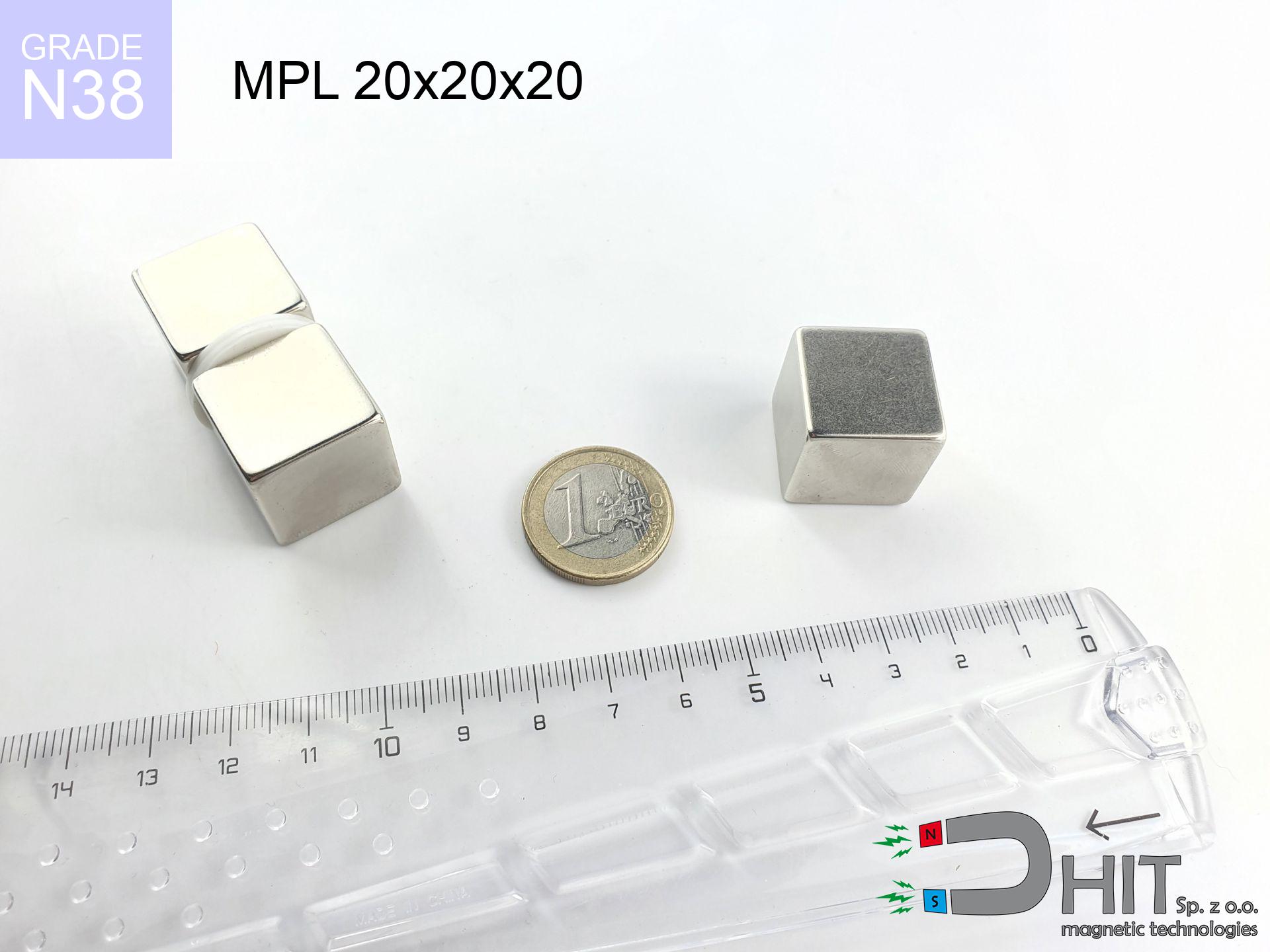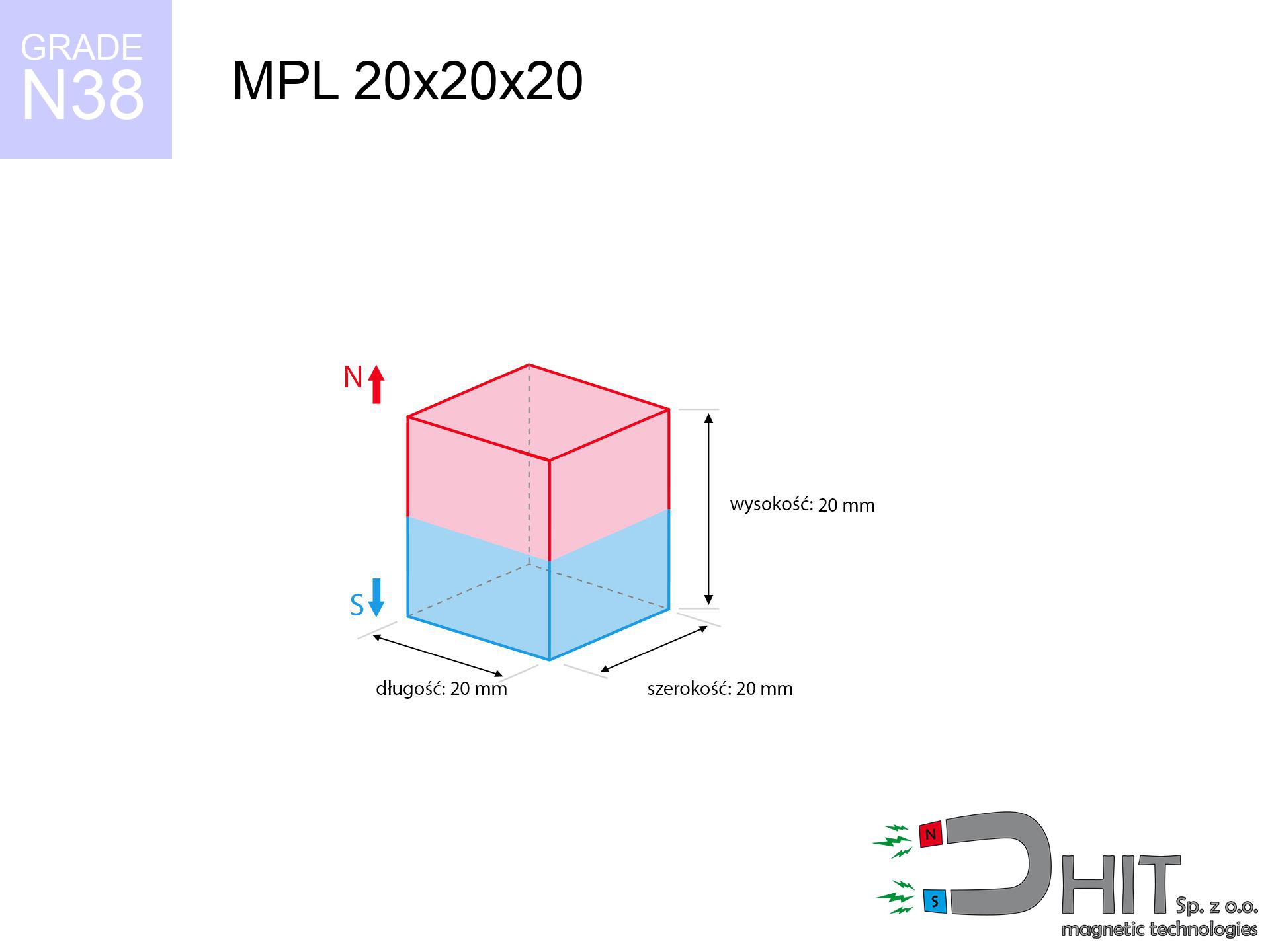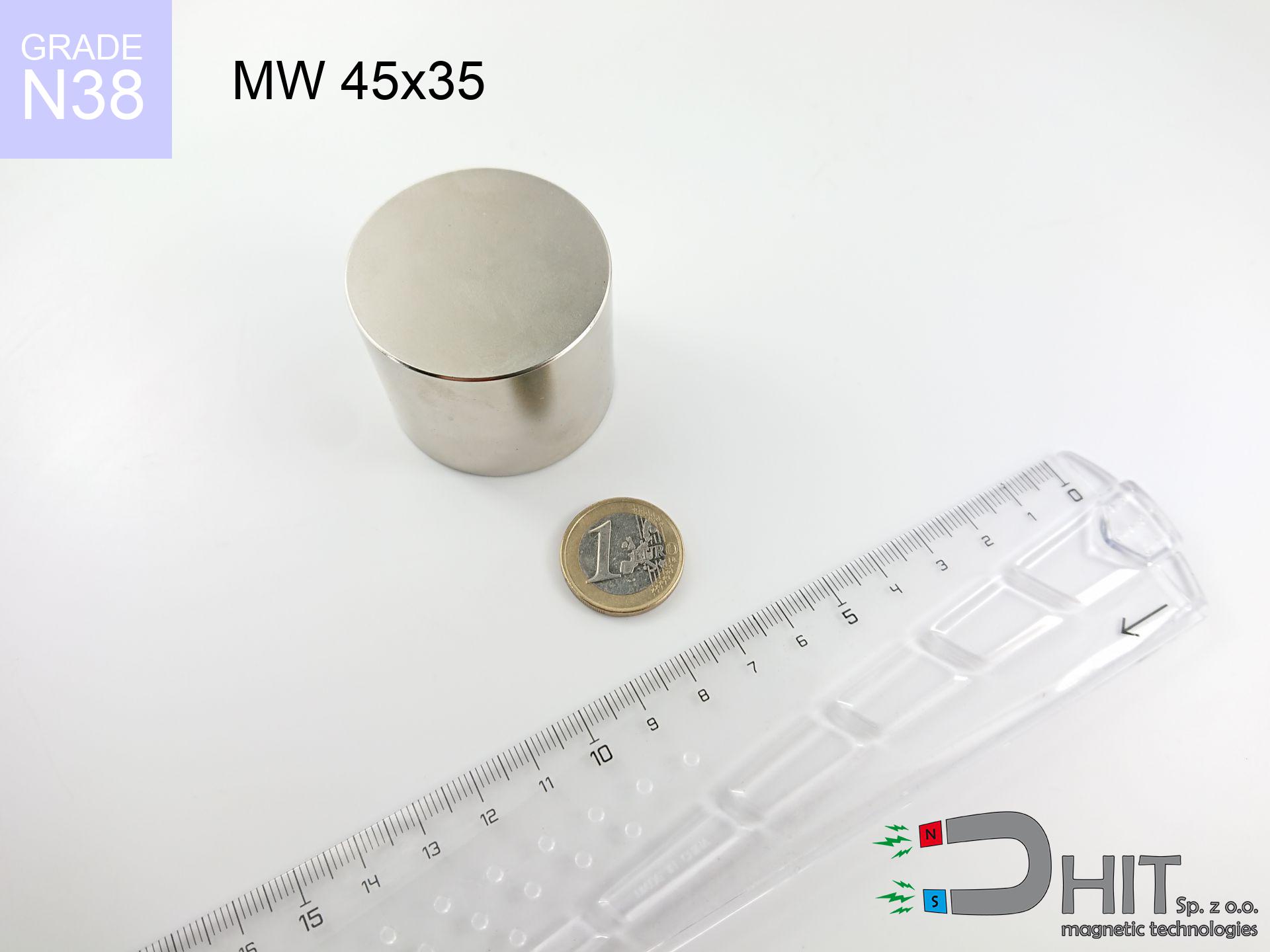MPL 20x20x20 / N38 - lamellar magnet
lamellar magnet
Catalog no 020129
GTIN/EAN: 5906301811350
length
20 mm [±0,1 mm]
Width
20 mm [±0,1 mm]
Height
20 mm [±0,1 mm]
Weight
60 g
Magnetization Direction
↑ axial
Load capacity
15.40 kg / 151.12 N
Magnetic Induction
540.22 mT / 5402 Gs
Coating
[NiCuNi] Nickel
33.21 ZŁ with VAT / pcs + price for transport
27.00 ZŁ net + 23% VAT / pcs
bulk discounts:
Need more?
Give us a call
+48 22 499 98 98
otherwise contact us through
contact form
the contact form page.
Parameters as well as form of neodymium magnets can be calculated on our
our magnetic calculator.
Orders placed before 14:00 will be shipped the same business day.
Technical of the product - MPL 20x20x20 / N38 - lamellar magnet
Specification / characteristics - MPL 20x20x20 / N38 - lamellar magnet
| properties | values |
|---|---|
| Cat. no. | 020129 |
| GTIN/EAN | 5906301811350 |
| Production/Distribution | Dhit sp. z o.o. |
| Country of origin | Poland / China / Germany |
| Customs code | 85059029 |
| length | 20 mm [±0,1 mm] |
| Width | 20 mm [±0,1 mm] |
| Height | 20 mm [±0,1 mm] |
| Weight | 60 g |
| Magnetization Direction | ↑ axial |
| Load capacity ~ ? | 15.40 kg / 151.12 N |
| Magnetic Induction ~ ? | 540.22 mT / 5402 Gs |
| Coating | [NiCuNi] Nickel |
| Manufacturing Tolerance | ±0.1 mm |
Magnetic properties of material N38
| properties | values | units |
|---|---|---|
| remenance Br [min. - max.] ? | 12.2-12.6 | kGs |
| remenance Br [min. - max.] ? | 1220-1260 | mT |
| coercivity bHc ? | 10.8-11.5 | kOe |
| coercivity bHc ? | 860-915 | kA/m |
| actual internal force iHc | ≥ 12 | kOe |
| actual internal force iHc | ≥ 955 | kA/m |
| energy density [min. - max.] ? | 36-38 | BH max MGOe |
| energy density [min. - max.] ? | 287-303 | BH max KJ/m |
| max. temperature ? | ≤ 80 | °C |
Physical properties of sintered neodymium magnets Nd2Fe14B at 20°C
| properties | values | units |
|---|---|---|
| Vickers hardness | ≥550 | Hv |
| Density | ≥7.4 | g/cm3 |
| Curie Temperature TC | 312 - 380 | °C |
| Curie Temperature TF | 593 - 716 | °F |
| Specific resistance | 150 | μΩ⋅cm |
| Bending strength | 250 | MPa |
| Compressive strength | 1000~1100 | MPa |
| Thermal expansion parallel (∥) to orientation (M) | (3-4) x 10-6 | °C-1 |
| Thermal expansion perpendicular (⊥) to orientation (M) | -(1-3) x 10-6 | °C-1 |
| Young's modulus | 1.7 x 104 | kg/mm² |
Physical modeling of the assembly - data
Presented values represent the outcome of a engineering calculation. Values were calculated on algorithms for the class Nd2Fe14B. Real-world performance may differ. Please consider these calculations as a supplementary guide during assembly planning.
Table 1: Static pull force (force vs gap) - power drop
MPL 20x20x20 / N38
| Distance (mm) | Induction (Gauss) / mT | Pull Force (kg/lbs/g/N) | Risk Status |
|---|---|---|---|
| 0 mm |
5400 Gs
540.0 mT
|
15.40 kg / 33.95 LBS
15400.0 g / 151.1 N
|
critical level |
| 1 mm |
4910 Gs
491.0 mT
|
12.73 kg / 28.07 LBS
12732.2 g / 124.9 N
|
critical level |
| 2 mm |
4423 Gs
442.3 mT
|
10.33 kg / 22.77 LBS
10328.3 g / 101.3 N
|
critical level |
| 3 mm |
3955 Gs
395.5 mT
|
8.26 kg / 18.21 LBS
8258.3 g / 81.0 N
|
warning |
| 5 mm |
3114 Gs
311.4 mT
|
5.12 kg / 11.29 LBS
5120.3 g / 50.2 N
|
warning |
| 10 mm |
1671 Gs
167.1 mT
|
1.48 kg / 3.25 LBS
1475.0 g / 14.5 N
|
low risk |
| 15 mm |
936 Gs
93.6 mT
|
0.46 kg / 1.02 LBS
463.0 g / 4.5 N
|
low risk |
| 20 mm |
562 Gs
56.2 mT
|
0.17 kg / 0.37 LBS
167.1 g / 1.6 N
|
low risk |
| 30 mm |
244 Gs
24.4 mT
|
0.03 kg / 0.07 LBS
31.3 g / 0.3 N
|
low risk |
| 50 mm |
73 Gs
7.3 mT
|
0.00 kg / 0.01 LBS
2.8 g / 0.0 N
|
low risk |
Table 2: Slippage capacity (wall)
MPL 20x20x20 / N38
| Distance (mm) | Friction coefficient | Pull Force (kg/lbs/g/N) |
|---|---|---|
| 0 mm | Stal (~0.2) |
3.08 kg / 6.79 LBS
3080.0 g / 30.2 N
|
| 1 mm | Stal (~0.2) |
2.55 kg / 5.61 LBS
2546.0 g / 25.0 N
|
| 2 mm | Stal (~0.2) |
2.07 kg / 4.55 LBS
2066.0 g / 20.3 N
|
| 3 mm | Stal (~0.2) |
1.65 kg / 3.64 LBS
1652.0 g / 16.2 N
|
| 5 mm | Stal (~0.2) |
1.02 kg / 2.26 LBS
1024.0 g / 10.0 N
|
| 10 mm | Stal (~0.2) |
0.30 kg / 0.65 LBS
296.0 g / 2.9 N
|
| 15 mm | Stal (~0.2) |
0.09 kg / 0.20 LBS
92.0 g / 0.9 N
|
| 20 mm | Stal (~0.2) |
0.03 kg / 0.07 LBS
34.0 g / 0.3 N
|
| 30 mm | Stal (~0.2) |
0.01 kg / 0.01 LBS
6.0 g / 0.1 N
|
| 50 mm | Stal (~0.2) |
0.00 kg / 0.00 LBS
0.0 g / 0.0 N
|
Table 3: Vertical assembly (sliding) - behavior on slippery surfaces
MPL 20x20x20 / N38
| Surface type | Friction coefficient / % Mocy | Max load (kg/lbs/g/N) |
|---|---|---|
| Raw steel |
µ = 0.3
30% Nominalnej Siły
|
4.62 kg / 10.19 LBS
4620.0 g / 45.3 N
|
| Painted steel (standard) |
µ = 0.2
20% Nominalnej Siły
|
3.08 kg / 6.79 LBS
3080.0 g / 30.2 N
|
| Oily/slippery steel |
µ = 0.1
10% Nominalnej Siły
|
1.54 kg / 3.40 LBS
1540.0 g / 15.1 N
|
| Magnet with anti-slip rubber |
µ = 0.5
50% Nominalnej Siły
|
7.70 kg / 16.98 LBS
7700.0 g / 75.5 N
|
Table 4: Material efficiency (saturation) - sheet metal selection
MPL 20x20x20 / N38
| Steel thickness (mm) | % power | Real pull force (kg/lbs/g/N) |
|---|---|---|
| 0.5 mm |
|
0.77 kg / 1.70 LBS
770.0 g / 7.6 N
|
| 1 mm |
|
1.93 kg / 4.24 LBS
1925.0 g / 18.9 N
|
| 2 mm |
|
3.85 kg / 8.49 LBS
3850.0 g / 37.8 N
|
| 3 mm |
|
5.78 kg / 12.73 LBS
5775.0 g / 56.7 N
|
| 5 mm |
|
9.63 kg / 21.22 LBS
9625.0 g / 94.4 N
|
| 10 mm |
|
15.40 kg / 33.95 LBS
15400.0 g / 151.1 N
|
| 11 mm |
|
15.40 kg / 33.95 LBS
15400.0 g / 151.1 N
|
| 12 mm |
|
15.40 kg / 33.95 LBS
15400.0 g / 151.1 N
|
Table 5: Thermal resistance (material behavior) - resistance threshold
MPL 20x20x20 / N38
| Ambient temp. (°C) | Power loss | Remaining pull (kg/lbs/g/N) | Status |
|---|---|---|---|
| 20 °C | 0.0% |
15.40 kg / 33.95 LBS
15400.0 g / 151.1 N
|
OK |
| 40 °C | -2.2% |
15.06 kg / 33.20 LBS
15061.2 g / 147.8 N
|
OK |
| 60 °C | -4.4% |
14.72 kg / 32.46 LBS
14722.4 g / 144.4 N
|
OK |
| 80 °C | -6.6% |
14.38 kg / 31.71 LBS
14383.6 g / 141.1 N
|
|
| 100 °C | -28.8% |
10.96 kg / 24.17 LBS
10964.8 g / 107.6 N
|
Table 6: Magnet-Magnet interaction (repulsion) - field collision
MPL 20x20x20 / N38
| Gap (mm) | Attraction (kg/lbs) (N-S) | Shear Strength (kg/lbs/g/N) | Repulsion (kg/lbs) (N-N) |
|---|---|---|---|
| 0 mm |
71.92 kg / 158.55 LBS
5 962 Gs
|
10.79 kg / 23.78 LBS
10787 g / 105.8 N
|
N/A |
| 1 mm |
65.60 kg / 144.63 LBS
10 316 Gs
|
9.84 kg / 21.69 LBS
9840 g / 96.5 N
|
59.04 kg / 130.16 LBS
~0 Gs
|
| 2 mm |
59.46 kg / 131.08 LBS
9 821 Gs
|
8.92 kg / 19.66 LBS
8919 g / 87.5 N
|
53.51 kg / 117.97 LBS
~0 Gs
|
| 3 mm |
53.66 kg / 118.30 LBS
9 329 Gs
|
8.05 kg / 17.74 LBS
8049 g / 79.0 N
|
48.29 kg / 106.47 LBS
~0 Gs
|
| 5 mm |
43.20 kg / 95.24 LBS
8 371 Gs
|
6.48 kg / 14.29 LBS
6480 g / 63.6 N
|
38.88 kg / 85.71 LBS
~0 Gs
|
| 10 mm |
23.91 kg / 52.72 LBS
6 228 Gs
|
3.59 kg / 7.91 LBS
3587 g / 35.2 N
|
21.52 kg / 47.44 LBS
~0 Gs
|
| 20 mm |
6.89 kg / 15.19 LBS
3 343 Gs
|
1.03 kg / 2.28 LBS
1033 g / 10.1 N
|
6.20 kg / 13.67 LBS
~0 Gs
|
| 50 mm |
0.32 kg / 0.71 LBS
721 Gs
|
0.05 kg / 0.11 LBS
48 g / 0.5 N
|
0.29 kg / 0.64 LBS
~0 Gs
|
| 60 mm |
0.15 kg / 0.32 LBS
487 Gs
|
0.02 kg / 0.05 LBS
22 g / 0.2 N
|
0.13 kg / 0.29 LBS
~0 Gs
|
| 70 mm |
0.07 kg / 0.16 LBS
344 Gs
|
0.01 kg / 0.02 LBS
11 g / 0.1 N
|
0.07 kg / 0.14 LBS
~0 Gs
|
| 80 mm |
0.04 kg / 0.09 LBS
251 Gs
|
0.01 kg / 0.01 LBS
6 g / 0.1 N
|
0.04 kg / 0.08 LBS
~0 Gs
|
| 90 mm |
0.02 kg / 0.05 LBS
189 Gs
|
0.00 kg / 0.01 LBS
3 g / 0.0 N
|
0.02 kg / 0.04 LBS
~0 Gs
|
| 100 mm |
0.01 kg / 0.03 LBS
146 Gs
|
0.00 kg / 0.00 LBS
2 g / 0.0 N
|
0.01 kg / 0.03 LBS
~0 Gs
|
Table 7: Protective zones (implants) - warnings
MPL 20x20x20 / N38
| Object / Device | Limit (Gauss) / mT | Safe distance |
|---|---|---|
| Pacemaker | 5 Gs (0.5 mT) | 14.0 cm |
| Hearing aid | 10 Gs (1.0 mT) | 11.0 cm |
| Mechanical watch | 20 Gs (2.0 mT) | 8.5 cm |
| Phone / Smartphone | 40 Gs (4.0 mT) | 6.5 cm |
| Car key | 50 Gs (5.0 mT) | 6.0 cm |
| Payment card | 400 Gs (40.0 mT) | 2.5 cm |
| HDD hard drive | 600 Gs (60.0 mT) | 2.0 cm |
Table 8: Collisions (cracking risk) - warning
MPL 20x20x20 / N38
| Start from (mm) | Speed (km/h) | Energy (J) | Predicted outcome |
|---|---|---|---|
| 10 mm |
17.10 km/h
(4.75 m/s)
|
0.68 J | |
| 30 mm |
28.02 km/h
(7.78 m/s)
|
1.82 J | |
| 50 mm |
36.13 km/h
(10.04 m/s)
|
3.02 J | |
| 100 mm |
51.09 km/h
(14.19 m/s)
|
6.04 J |
Table 9: Coating parameters (durability)
MPL 20x20x20 / N38
| Technical parameter | Value / Description |
|---|---|
| Coating type | [NiCuNi] Nickel |
| Layer structure | Nickel - Copper - Nickel |
| Layer thickness | 10-20 µm |
| Salt spray test (SST) ? | 24 h |
| Recommended environment | Indoors only (dry) |
Table 10: Construction data (Pc)
MPL 20x20x20 / N38
| Parameter | Value | SI Unit / Description |
|---|---|---|
| Magnetic Flux | 22 017 Mx | 220.2 µWb |
| Pc Coefficient | 0.84 | High (Stable) |
Table 11: Hydrostatics and buoyancy
MPL 20x20x20 / N38
| Environment | Effective steel pull | Effect |
|---|---|---|
| Air (land) | 15.40 kg | Standard |
| Water (riverbed) |
17.63 kg
(+2.23 kg buoyancy gain)
|
+14.5% |
1. Sliding resistance
*Warning: On a vertical wall, the magnet retains just a fraction of its perpendicular strength.
2. Plate thickness effect
*Thin steel (e.g. 0.5mm PC case) significantly reduces the holding force.
3. Power loss vs temp
*For N38 grade, the safety limit is 80°C.
4. Demagnetization curve and operating point (B-H)
chart generated for the permeance coefficient Pc (Permeance Coefficient) = 0.84
The chart above illustrates the magnetic characteristics of the material within the second quadrant of the hysteresis loop. The solid red line represents the demagnetization curve (material potential), while the dashed blue line is the load line based on the magnet's geometry. The Pc (Permeance Coefficient), also known as the load line slope, is a dimensionless value that describes the relationship between the magnet's shape and its magnetic stability. The intersection of these two lines (the black dot) is the operating point — it determines the actual magnetic flux density generated by the magnet in this specific configuration. A higher Pc value means the magnet is more 'slender' (tall relative to its area), resulting in a higher operating point and better resistance to irreversible demagnetization caused by external fields or temperature. A value of 0.42 is relatively low (typical for flat magnets), meaning the operating point is closer to the 'knee' of the curve — caution is advised when operating at temperatures near the maximum limit to avoid strength loss.
Chemical composition
| iron (Fe) | 64% – 68% |
| neodymium (Nd) | 29% – 32% |
| boron (B) | 1.1% – 1.2% |
| dysprosium (Dy) | 0.5% – 2.0% |
| coating (Ni-Cu-Ni) | < 0.05% |
Environmental data
| recyclability (EoL) | 100% |
| recycled raw materials | ~10% (pre-cons) |
| carbon footprint | low / zredukowany |
| waste code (EWC) | 16 02 16 |
See also deals
Strengths and weaknesses of rare earth magnets.
Pros
- They have stable power, and over around 10 years their performance decreases symbolically – ~1% (according to theory),
- Magnets effectively protect themselves against loss of magnetization caused by external fields,
- Thanks to the shimmering finish, the surface of nickel, gold, or silver-plated gives an elegant appearance,
- Magnets exhibit huge magnetic induction on the surface,
- Thanks to resistance to high temperature, they are able to function (depending on the shape) even at temperatures up to 230°C and higher...
- Thanks to modularity in designing and the ability to modify to complex applications,
- Fundamental importance in high-tech industry – they find application in HDD drives, motor assemblies, diagnostic systems, also other advanced devices.
- Relatively small size with high pulling force – neodymium magnets offer impressive pulling force in small dimensions, which enables their usage in miniature devices
Disadvantages
- To avoid cracks upon strong impacts, we recommend using special steel housings. Such a solution protects the magnet and simultaneously increases its durability.
- Neodymium magnets lose their force under the influence of heating. As soon as 80°C is exceeded, many of them start losing their power. Therefore, we recommend our special magnets marked [AH], which maintain durability even at temperatures up to 230°C
- They oxidize in a humid environment. For use outdoors we suggest using waterproof magnets e.g. in rubber, plastic
- Due to limitations in creating threads and complex forms in magnets, we recommend using cover - magnetic mount.
- Possible danger to health – tiny shards of magnets can be dangerous, in case of ingestion, which becomes key in the context of child health protection. Additionally, small elements of these magnets are able to be problematic in diagnostics medical when they are in the body.
- With mass production the cost of neodymium magnets is a challenge,
Lifting parameters
Maximum magnetic pulling force – what affects it?
- with the contact of a yoke made of low-carbon steel, ensuring maximum field concentration
- whose thickness equals approx. 10 mm
- with an ideally smooth touching surface
- without the slightest clearance between the magnet and steel
- for force applied at a right angle (pull-off, not shear)
- at standard ambient temperature
What influences lifting capacity in practice
- Distance – existence of foreign body (paint, dirt, gap) interrupts the magnetic circuit, which reduces power steeply (even by 50% at 0.5 mm).
- Force direction – declared lifting capacity refers to pulling vertically. When applying parallel force, the magnet exhibits much less (often approx. 20-30% of nominal force).
- Substrate thickness – for full efficiency, the steel must be sufficiently thick. Thin sheet restricts the attraction force (the magnet "punches through" it).
- Material type – ideal substrate is pure iron steel. Hardened steels may attract less.
- Plate texture – ground elements ensure maximum contact, which increases force. Uneven metal weaken the grip.
- Temperature influence – high temperature weakens magnetic field. Too high temperature can permanently demagnetize the magnet.
Lifting capacity testing was conducted on a smooth plate of optimal thickness, under perpendicular forces, whereas under parallel forces the holding force is lower. Moreover, even a minimal clearance between the magnet and the plate reduces the holding force.
Safe handling of neodymium magnets
Fire warning
Combustion risk: Neodymium dust is explosive. Do not process magnets without safety gear as this risks ignition.
Eye protection
Despite metallic appearance, the material is delicate and cannot withstand shocks. Do not hit, as the magnet may shatter into sharp, dangerous pieces.
GPS Danger
An intense magnetic field negatively affects the functioning of magnetometers in smartphones and navigation systems. Do not bring magnets close to a device to prevent damaging the sensors.
Caution required
Before use, read the rules. Sudden snapping can break the magnet or hurt your hand. Be predictive.
Permanent damage
Avoid heat. NdFeB magnets are sensitive to temperature. If you need resistance above 80°C, look for special high-temperature series (H, SH, UH).
Avoid contact if allergic
Some people suffer from a hypersensitivity to Ni, which is the typical protective layer for NdFeB magnets. Prolonged contact can result in skin redness. We recommend wear safety gloves.
No play value
Neodymium magnets are not toys. Eating a few magnets can lead to them connecting inside the digestive tract, which constitutes a critical condition and necessitates urgent medical intervention.
Health Danger
Individuals with a heart stimulator should keep an large gap from magnets. The magnetic field can stop the functioning of the implant.
Finger safety
Protect your hands. Two large magnets will join immediately with a force of several hundred kilograms, crushing anything in their path. Be careful!
Protect data
Do not bring magnets near a purse, computer, or TV. The magnetism can destroy these devices and wipe information from cards.




![UI 39x9x7 [BA] - badge holder UI 39x9x7 [BA] - badge holder](https://cdn3.dhit.pl/graphics/products/ui39x9x7-dav.jpg)




